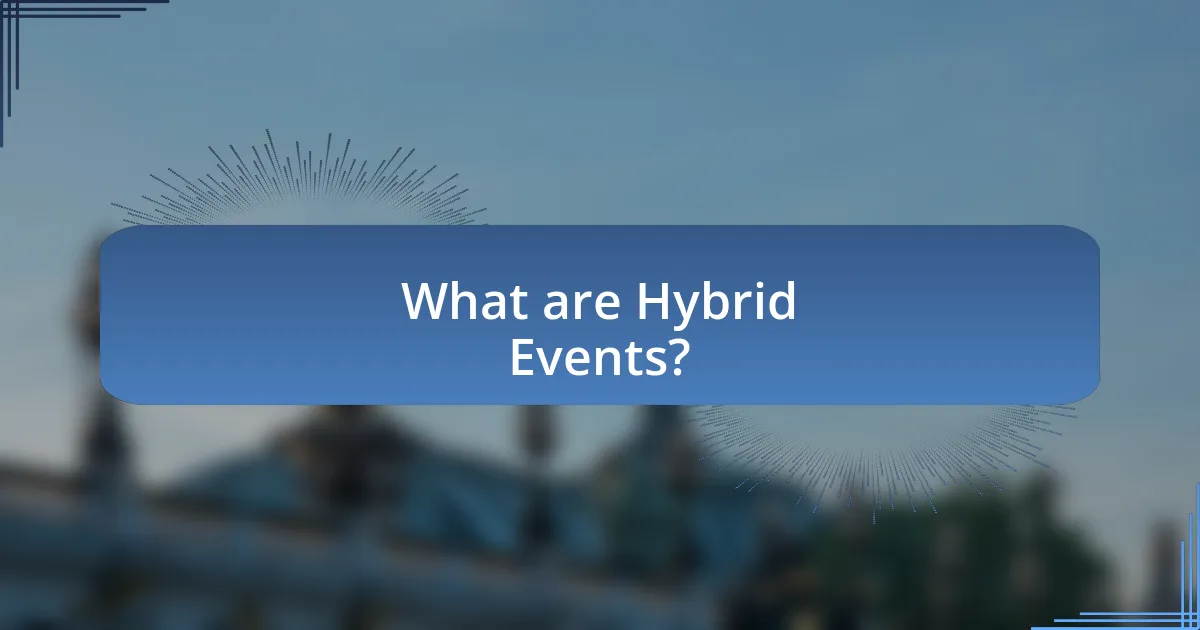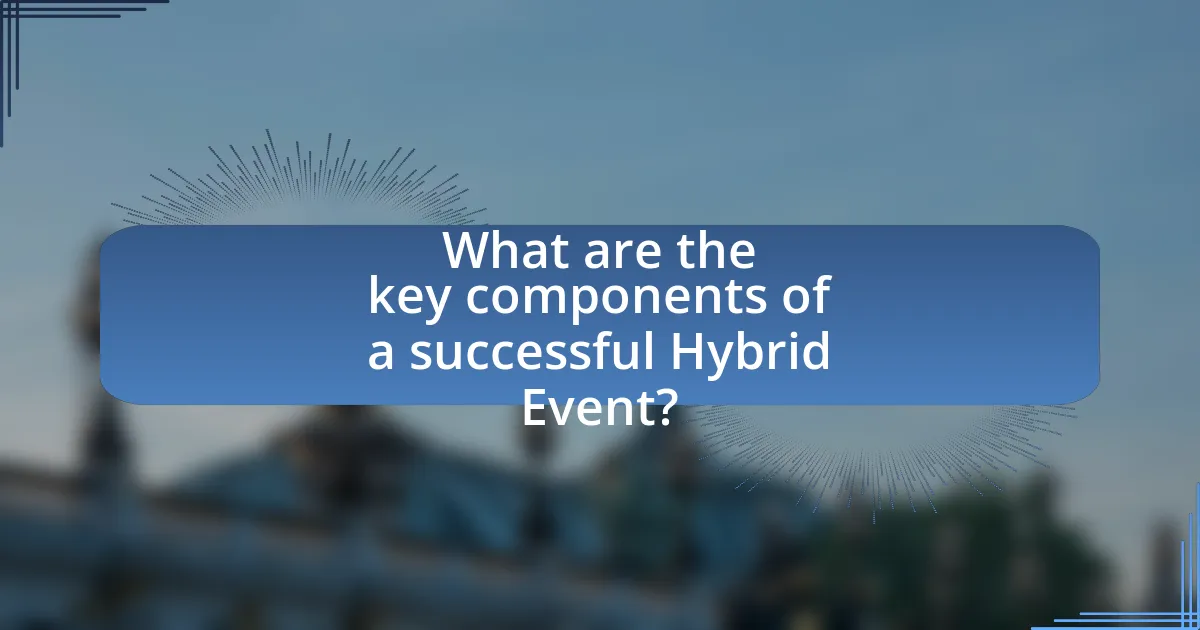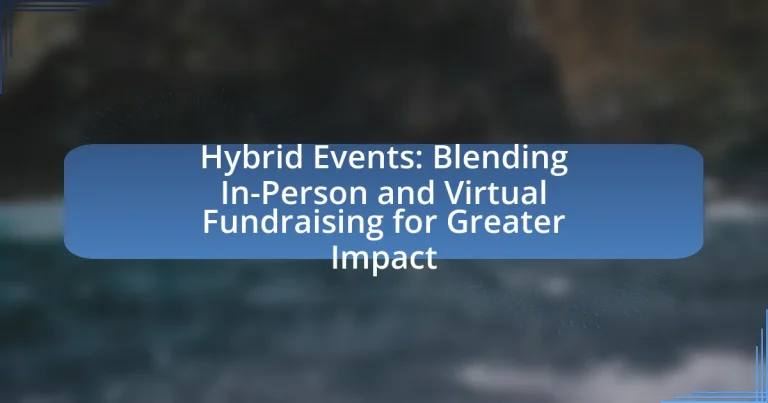Hybrid events are gatherings that integrate both in-person and virtual participation, allowing organizations to expand their reach and enhance engagement. This article explores the definition and components of hybrid events, emphasizing their growing popularity in fundraising due to increased accessibility and audience engagement. Key topics include essential technologies for successful hybrid events, logistical differences between in-person and virtual components, and strategies for maximizing fundraising potential. Additionally, the article addresses challenges faced by hybrid events and offers best practices for effective planning, promotion, and post-event engagement to ensure a seamless experience for all attendees.

What are Hybrid Events?
Hybrid events are gatherings that combine both in-person and virtual participation, allowing attendees to engage through multiple formats. This approach enables organizations to reach a broader audience, as individuals can join from anywhere in the world while still providing opportunities for face-to-face interaction. The effectiveness of hybrid events is supported by the increasing trend of digital engagement, with a report from Eventbrite indicating that 67% of event organizers plan to incorporate hybrid formats to enhance accessibility and inclusivity.
How do Hybrid Events combine in-person and virtual elements?
Hybrid events combine in-person and virtual elements by allowing attendees to participate through both physical presence and online platforms. This integration enables organizers to reach a broader audience, as in-person attendees engage directly at the venue while virtual participants join via live streaming or interactive platforms. For instance, technology such as video conferencing tools and event apps facilitates real-time interaction, allowing virtual attendees to ask questions and participate in discussions alongside those present physically. This dual approach not only enhances accessibility but also maximizes engagement, as evidenced by a report from Eventbrite, which states that hybrid events can increase attendance by up to 30% compared to traditional in-person events alone.
What technologies are essential for successful Hybrid Events?
Essential technologies for successful hybrid events include high-quality video conferencing platforms, reliable streaming services, interactive event apps, and audience engagement tools. Video conferencing platforms like Zoom or Microsoft Teams facilitate real-time communication between in-person and virtual attendees, ensuring seamless interaction. Reliable streaming services, such as Vimeo or YouTube Live, enable high-definition broadcasting of the event to remote participants. Interactive event apps, like Whova or Eventbrite, enhance attendee experience by providing schedules, networking opportunities, and live polls. Audience engagement tools, such as Slido or Mentimeter, allow for real-time feedback and interaction, fostering a sense of community among participants. These technologies collectively ensure that hybrid events are engaging, accessible, and impactful for all attendees.
How do logistics differ between in-person and virtual components?
Logistics for in-person components involve physical arrangements such as venue selection, seating arrangements, catering, and on-site staff management, while virtual components require digital infrastructure, including platform selection, internet bandwidth, and technical support for participants. In-person logistics necessitate coordination of physical resources and personnel to ensure a seamless experience, whereas virtual logistics focus on technology and user accessibility to facilitate engagement. For example, a study by Eventbrite highlights that 70% of event organizers prioritize technology setup for virtual events, underscoring the distinct logistical needs between the two formats.
Why are Hybrid Events becoming popular in fundraising?
Hybrid events are becoming popular in fundraising because they combine the benefits of in-person and virtual participation, maximizing reach and engagement. This format allows organizations to attract a broader audience, as individuals can join from anywhere, increasing potential donations. According to a report by Eventbrite, 67% of event organizers noted that hybrid events helped them reach new audiences, demonstrating their effectiveness in expanding donor bases. Additionally, hybrid events provide flexibility, accommodating varying comfort levels regarding in-person gatherings, which has become increasingly important in the post-pandemic landscape.
What advantages do Hybrid Events offer to fundraisers?
Hybrid events offer fundraisers increased reach and engagement by combining in-person and virtual participation. This format allows fundraisers to attract a larger audience, as individuals who may not be able to attend physically can still participate online. According to a report by Eventbrite, hybrid events can increase attendance by up to 30%, enabling fundraisers to connect with more donors and supporters. Additionally, hybrid events provide diverse revenue streams through ticket sales, sponsorships, and online donations, enhancing overall fundraising potential.
How do Hybrid Events enhance audience engagement?
Hybrid events enhance audience engagement by combining in-person and virtual experiences, allowing for broader participation and interaction. This dual format caters to diverse audience preferences, enabling those who cannot attend physically to engage through live streaming, chat features, and interactive polls. Research indicates that hybrid events can increase attendance by up to 30%, as they remove geographical barriers and provide flexible options for participation. Additionally, the integration of technology facilitates real-time feedback and networking opportunities, further enriching the audience experience and fostering a sense of community among participants.

What are the key components of a successful Hybrid Event?
The key components of a successful Hybrid Event include seamless technology integration, engaging content, effective audience interaction, and robust marketing strategies. Seamless technology integration ensures that both in-person and virtual attendees have a smooth experience, utilizing reliable platforms for streaming and interaction. Engaging content captivates both audiences, often through dynamic presentations and interactive sessions that encourage participation. Effective audience interaction fosters a sense of community, allowing for real-time Q&A sessions and networking opportunities that bridge the gap between physical and virtual attendees. Robust marketing strategies are essential for promoting the event to a diverse audience, leveraging social media and email campaigns to maximize reach and engagement. These components collectively enhance the overall experience and impact of Hybrid Events.
How can event organizers effectively plan Hybrid Events?
Event organizers can effectively plan hybrid events by integrating both in-person and virtual components seamlessly. This involves selecting a reliable technology platform that supports live streaming and interactive features, ensuring high-quality audio and video for remote participants. Additionally, organizers should create an engaging agenda that caters to both audiences, incorporating interactive elements like polls and Q&A sessions to foster participation.
Furthermore, promoting the event through targeted marketing strategies that reach both local and online audiences is crucial. According to a report by Eventbrite, 67% of event organizers believe that hybrid events can increase attendance and engagement, highlighting the importance of a well-structured approach. By focusing on these key areas, event organizers can maximize the impact of their hybrid events.
What role does audience segmentation play in planning?
Audience segmentation plays a critical role in planning by enabling organizers to tailor their strategies to specific groups within their target audience. This targeted approach enhances engagement and effectiveness, as different segments may have varying preferences, motivations, and behaviors. For instance, research indicates that segmented marketing campaigns can lead to a 760% increase in revenue, demonstrating the financial benefits of understanding audience diversity. By analyzing demographics, interests, and past behaviors, planners can create personalized experiences that resonate with each segment, ultimately driving higher participation and satisfaction in hybrid events.
How can organizers ensure a seamless experience for both in-person and virtual attendees?
Organizers can ensure a seamless experience for both in-person and virtual attendees by implementing integrated technology solutions that facilitate real-time interaction and engagement. Utilizing platforms that support live streaming, chat functions, and audience polling allows both groups to participate actively, fostering a sense of community. For instance, a study by the Event Marketing Institute found that 70% of attendees prefer events that offer interactive elements, highlighting the importance of engagement tools. Additionally, providing clear communication regarding the event schedule and access instructions for virtual attendees ensures that all participants are informed and can navigate the event smoothly.
What strategies can enhance fundraising during Hybrid Events?
To enhance fundraising during hybrid events, organizations should implement targeted engagement strategies that cater to both in-person and virtual attendees. Utilizing interactive technology, such as live polling and Q&A sessions, fosters real-time participation and connection among attendees, increasing their likelihood of donating. Additionally, offering exclusive content or experiences for both groups can incentivize contributions; for instance, virtual attendees might receive behind-the-scenes access or special guest appearances.
Data supports the effectiveness of these strategies; a study by the Association of Fundraising Professionals found that events incorporating interactive elements saw a 30% increase in donor engagement compared to traditional formats. Furthermore, leveraging social media for live updates and donation prompts can amplify reach and encourage spontaneous giving, as evidenced by a 2021 report from Nonprofit Tech for Good, which indicated that organizations utilizing social media during events raised 50% more funds than those that did not.
How can technology facilitate donations during Hybrid Events?
Technology facilitates donations during hybrid events by enabling seamless integration of online and offline fundraising platforms. For instance, mobile donation apps and websites allow attendees, whether present in-person or participating virtually, to contribute easily through secure payment gateways. According to a report by the Fundraising Effectiveness Project, organizations that utilized digital tools for fundraising saw an increase in donations by up to 30% during hybrid events compared to traditional methods. Additionally, live streaming features can include real-time donation tracking, encouraging competition and engagement among participants, which further boosts contributions.
What types of fundraising activities work best in a Hybrid format?
Fundraising activities that work best in a hybrid format include virtual auctions, online donation drives, and live-streamed events. Virtual auctions allow participants to bid from anywhere, increasing engagement and reach, while online donation drives can leverage social media to attract a wider audience. Live-streamed events, such as galas or performances, enable in-person attendees to interact with virtual participants, fostering a sense of community. According to a report by the Nonprofit Research Collaborative, hybrid events can increase fundraising revenue by up to 30% compared to traditional formats, demonstrating their effectiveness in maximizing participation and contributions.

What challenges do Hybrid Events face?
Hybrid events face several challenges, including technical issues, audience engagement, and logistical complexities. Technical issues can arise from unreliable internet connections or inadequate technology, which can disrupt the experience for both in-person and virtual attendees. Audience engagement is often difficult to achieve, as virtual participants may feel disconnected from the event, leading to lower participation rates. Logistical complexities involve coordinating schedules, managing different formats, and ensuring a seamless experience for all attendees, which can strain resources and planning efforts. These challenges can hinder the overall effectiveness and impact of hybrid events.
How can organizers overcome technical difficulties?
Organizers can overcome technical difficulties by implementing thorough pre-event testing and ensuring reliable technical support. Conducting tests on all equipment and software before the event helps identify potential issues, allowing for timely resolutions. Additionally, having a dedicated technical support team available during the event can address any unforeseen problems quickly, minimizing disruptions. Research indicates that 70% of event organizers who conduct pre-event technical checks report fewer issues during the actual event, highlighting the effectiveness of this approach.
What are common technical issues encountered during Hybrid Events?
Common technical issues encountered during hybrid events include connectivity problems, audio-visual discrepancies, and platform compatibility challenges. Connectivity issues often arise due to unstable internet connections, which can disrupt live streaming and audience engagement. Audio-visual discrepancies may occur when the sound or video quality differs between in-person and virtual participants, leading to confusion and disengagement. Additionally, platform compatibility challenges can hinder seamless integration of various technologies used for broadcasting and interaction, affecting the overall experience for both in-person and online attendees. These issues can significantly impact the effectiveness of hybrid events, as evidenced by numerous case studies highlighting the importance of robust technical infrastructure to ensure smooth execution.
How can organizers prepare for unexpected challenges?
Organizers can prepare for unexpected challenges by developing a comprehensive contingency plan that addresses potential risks associated with hybrid events. This plan should include clear protocols for technical failures, health and safety issues, and participant engagement disruptions. For instance, a study by the Event Safety Alliance highlights that having backup technology and alternative communication methods can significantly mitigate the impact of unforeseen technical difficulties. Additionally, conducting regular risk assessments and simulations can help organizers identify vulnerabilities and refine their response strategies, ensuring a smoother execution of both in-person and virtual components of the event.
What are the best practices for promoting Hybrid Events?
The best practices for promoting hybrid events include leveraging multiple marketing channels, engaging audiences through personalized content, and utilizing technology for seamless integration. Utilizing social media platforms, email marketing, and targeted advertisements can effectively reach diverse audiences. Engaging potential attendees with tailored content, such as sneak peeks or behind-the-scenes insights, fosters interest and excitement. Additionally, employing reliable technology ensures a smooth experience for both in-person and virtual participants, which is crucial for maintaining engagement and satisfaction. According to a study by Eventbrite, events that effectively use a mix of promotional strategies see a 30% increase in attendance compared to those that rely on a single channel.
How can social media be leveraged for Hybrid Event promotion?
Social media can be leveraged for hybrid event promotion by utilizing targeted advertising, engaging content, and real-time interaction. Targeted advertising on platforms like Facebook and Instagram allows event organizers to reach specific demographics, increasing visibility among potential attendees. Engaging content, such as behind-the-scenes videos, speaker highlights, and interactive polls, can generate interest and excitement leading up to the event. Real-time interaction during the event, through live streaming and social media updates, fosters community engagement and encourages participation from both in-person and virtual attendees. According to a study by Eventbrite, 80% of event organizers believe social media is crucial for promoting their events, highlighting its effectiveness in reaching broader audiences.
What messaging strategies resonate with both in-person and virtual audiences?
Messaging strategies that resonate with both in-person and virtual audiences include personalization, storytelling, and interactive engagement. Personalization allows messages to be tailored to individual preferences, enhancing relevance and connection for both audience types. Storytelling captivates attention and fosters emotional connections, making the content memorable regardless of the medium. Interactive engagement, such as polls or Q&A sessions, encourages participation and keeps both audiences involved, creating a sense of community. Research indicates that personalized content can increase engagement rates by up to 50%, while storytelling can improve retention by 65% compared to traditional messaging.
What practical tips can ensure the success of Hybrid Events?
To ensure the success of hybrid events, it is essential to prioritize seamless technology integration. This involves using reliable platforms that support both in-person and virtual attendees, ensuring high-quality audio and video. Research indicates that 70% of event professionals believe technology is crucial for hybrid event success, highlighting the importance of a robust technical setup. Additionally, engaging content tailored for both audiences can enhance participation; studies show that interactive elements, such as polls and Q&A sessions, increase attendee engagement by up to 50%. Finally, effective communication before, during, and after the event fosters a sense of community, which is vital for maintaining attendee interest and satisfaction.
How can feedback be effectively gathered from attendees?
Feedback can be effectively gathered from attendees through structured surveys and interactive tools. Utilizing post-event surveys, either digital or paper-based, allows organizers to collect quantitative and qualitative data on attendee experiences. Research indicates that 70% of event attendees prefer to provide feedback through online surveys, as they offer convenience and anonymity. Additionally, incorporating real-time feedback tools, such as live polls or Q&A sessions during the event, encourages immediate responses and engagement. This method not only captures attendee sentiments but also fosters a sense of involvement. By analyzing the collected data, organizers can identify strengths and areas for improvement, ultimately enhancing future hybrid events.
What follow-up strategies can maximize post-event engagement?
To maximize post-event engagement, organizations should implement personalized follow-up communications, such as tailored emails and surveys, to maintain participant interest and gather feedback. Personalized emails can increase open rates by 26%, as reported by Campaign Monitor, demonstrating the effectiveness of targeted messaging. Additionally, sending thank-you notes and sharing event highlights through social media or newsletters can reinforce connections and encourage ongoing interaction. Engaging participants with exclusive content or offers related to the event can further enhance their involvement and loyalty.


